Condition and Grade of Ancient Coins
What's new? March 27, 2023; Part O, "Condition matters!"
0) Condition matters! (Added March 27, 2023)
1) Part I: Grade vs. condition
2) Part II: The downside of grading
3) Part III: Slabs
4) Part IV: Tooling and Smoothing
Condition matters! Here are results from an auction conducted in March 2023 which show that is not just the coin type, but the condition the coin is in, that matters to its price.

A coin is better condition is worth more, and often a lot more, than one in unattractive condition.
Condition. The condition of a coin takes into account detractions regardless of source. The term grade is a technical term about wear which has an established definition I do not have the right to dispute. The modern use of grade refers to wear from "circulation" alone (according to US-coin standards), forcing us to use a different term, "condition," to (attempt to) describe desirability, if we use any term at all (A good photo is worth more than words.) To evaluate an ancient coin it is important to take into account things like centering, strike, style, and corrosion. They have nothing to do with wear.
US collectors seem to think "bagmarks" are not circulation, but the same detraction from a scratch or rub suffered in "circulation" is somehow worse. All right, US-coin collectors define the US-coin-collecting game and that is their rules. But, I collect ancient coins and US-coin rules do not have to apply. A coin could be fresh from the ancient mint, but if it is weakly struck or off-center enough to clip the legend, then the condition plummets, although the wear might be zero and the "grade" high. That is why NGC also has "strike" and "surface" factors (which they should have separately for the two sides--neither is necessarily the same on the two sides).
 Roman Republican silver denarius of Brutus.
Roman Republican silver denarius of Brutus.
54 BC. 18 mm. 3.45 grams.
Crawford 433/1. Sear I 397.
This coin of the famous Brutus would be much better if the surface were not porous, the word "LIBERTAS" were fully on the flan, and the four figures on the reverse were fully on the flan. Regardless of the wear since it left the mint, it has "problems" that detract from its desirability. There are far nicer examples with the same amount of wear.
In Selections from the Numismatist: Ancient and Medieval Coins, published in 1960 (long ago) an article entitled "Some Notes on Grading Ancient Coins" by Mead Kibbey has, under EF, "The grade indicates a full round flan, little or no wear, and no objectionable corrosion. All details of the design clear except perhaps a little wear on the highest parts or a single defect like a small nick." So, the term grade formerly considered things other than wear, but not any more
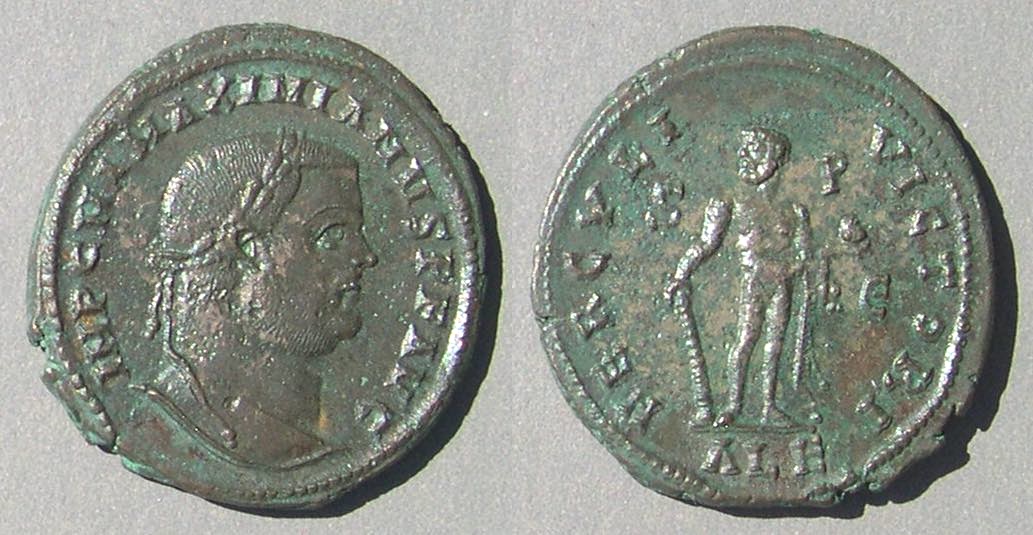 The coin to the right is a follis of Maximian (286-305), 27 mm. 10.63 grams. Reverse: HERCVLI VICTORI. RIC Alexandria 38. The highest spots, the ear and wreath on the obverse and the beard and right arm of Hercules on the reverse, show virtually no wear. But the chest of Hercules is not well-struck and the on the obverse the chin and back of the neck of have some corrosion pits. For wear alone it could hardly be better, but it does have detractions that are not due to wear. Its grade would be on a linear scale with one number, but there is no way that one number can describe the "condition" of this coin. Don't even try.
The coin to the right is a follis of Maximian (286-305), 27 mm. 10.63 grams. Reverse: HERCVLI VICTORI. RIC Alexandria 38. The highest spots, the ear and wreath on the obverse and the beard and right arm of Hercules on the reverse, show virtually no wear. But the chest of Hercules is not well-struck and the on the obverse the chin and back of the neck of have some corrosion pits. For wear alone it could hardly be better, but it does have detractions that are not due to wear. Its grade would be on a linear scale with one number, but there is no way that one number can describe the "condition" of this coin. Don't even try.
The point is, "grading" of ancient coins has long included factors other than wear. Modern mechanically-produced coins start out almost identical, so wear is, by far, the most significant factor in lowering desirability. Thus desirability is highly correlated with wear and therefore grade. However, that is decidedly not the case for ancient coins. The idea that a detraction is somehow less important because it was not due to circulation is not appropriate for ancient coins.
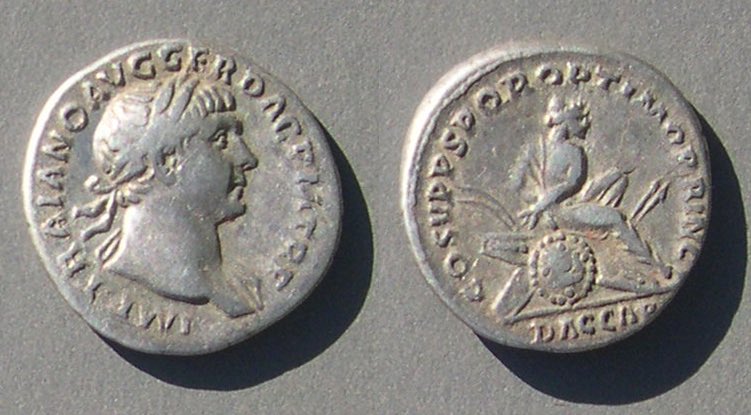 Quality. One way to think of the quality of a coin is to imagine a discussion of the type in a book (or web page). Would the coin make a good illustration? Is the legend visible? If you want to illustrate a "Dacian Captive" type under Trajan in a book and the coin is off-center so much that the "DACCAP" in exergue is off the flan, it may "grade" EF or UNC or Mint State, but it would not be a good example of the type.
Quality. One way to think of the quality of a coin is to imagine a discussion of the type in a book (or web page). Would the coin make a good illustration? Is the legend visible? If you want to illustrate a "Dacian Captive" type under Trajan in a book and the coin is off-center so much that the "DACCAP" in exergue is off the flan, it may "grade" EF or UNC or Mint State, but it would not be a good example of the type.
Trajan, 98-117 CE. Denarius. 18 mm.
DAC CAP, for Dacia Capta, in exergue. Celebrating his Dacian victory which Trajan's Column in Rome also celebrates.
Dacian captive, hands tied behind his back, in Dacian trousers, seated on a pile of captured arms, including shields of two types, spears, and curved weapons. RIC 96. Sear II 3136.
This coin shows substantial wear at the wreath near the top of his ear. Also, the strike could be stronger at the bottom of the obverse. An advanced collector would want a better example--that is, one with less wear and crisper strike (a coin that would cost much more, by the way). However, this coin, worn as it is, has almost no other detractions and preserves a clear image of the event that the Romans wanted to brag about. The grade might be slightly below VF, but its condition is well above many coins of the type that would grade VF. Learn that grade is a term that does not tell the whole story.
Return to the question about grading on page 3 of the FAQ pages for beginners.
Go to the main Table of Contents page for this whole group of pages.
Part II. The downside of grading
I feel a sigh of disappointment whenever the subject of grades comes up (for example, on this CoinTalk thread). Not because the contributions are wrong, but because of where the discussion inevitably, if unintentionally, leads.
US coin collecting drifted toward dull and expensive when grade took over and became a measurement of how worthwhile the coin was. Doubtless even long ago a higher grade coin was worth more than a lower grade coin of the same type-- I stipulate that. But the emphasis on grade changed the game, and not for the better. All the publications emphasized the highest grade pieces. You could hardy feel good about your coins unless they were top grade. An interesting and beautiful seated Liberty half dollar in XF was no longer regarded as beautiful--the grade was too low. Beauty, which we know is or should be in the eye of the beholder, was redefined to be a number on a slab.
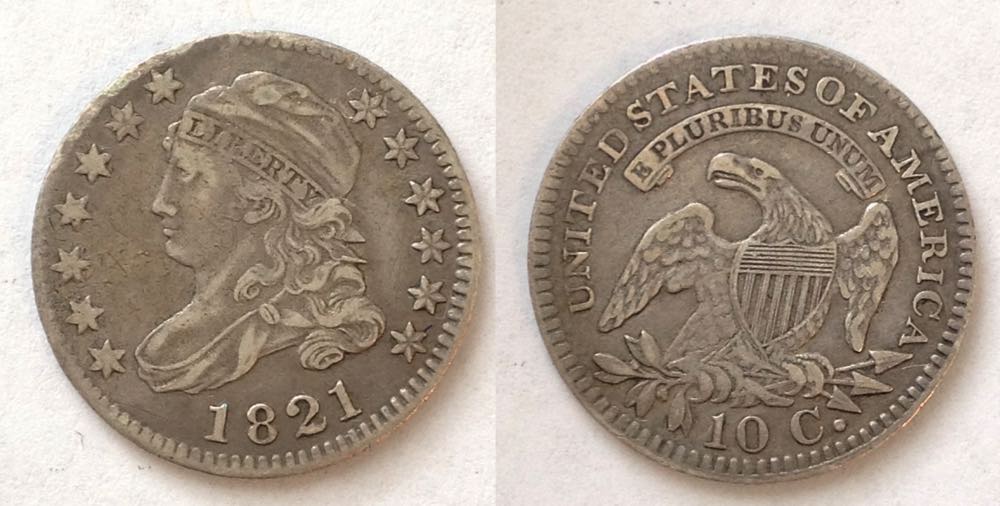 Now US coin collecting is sterile. You don't even need to look at the coin--just read the condition off the slab. Rich collectors at the top, unintentionally, but inevitably, determined what was desirable and the rest were trained by publications (Coin World, etc.) to devalue own collections and feel bad they did not have the best quality coins. Some collectors abandoned US coin collecting because of their inability to enjoy what they could afford.
Now US coin collecting is sterile. You don't even need to look at the coin--just read the condition off the slab. Rich collectors at the top, unintentionally, but inevitably, determined what was desirable and the rest were trained by publications (Coin World, etc.) to devalue own collections and feel bad they did not have the best quality coins. Some collectors abandoned US coin collecting because of their inability to enjoy what they could afford.
Look at the 1821 10-cent piece to the right. What do you see?
If you are a US coin collector, you probably are inspecting the boldness of "LIBERTY" and the wear on the eagles wings. After all, you need to know the grade to know whether you like the coin! The unspoken message of Coin World is that this is not a very nice coin; it is only VF. On the other hand, if you are an ancient-coin collector, you are probably wondering about the type, the stars, the "E PLURBIS UNUM" message, and the shield on the eagle's breast. That's interesting. I'd need to look up the history.
Devaluing History and Interest. Devaluing historical and interesting coins in favor of high-grade coins has even happened in ancients to some extent. Before the internet and digital images, collectors wrote articles for The Celator (the collectors' journal for ancient coins, since gone out of business) displaying their knowledge in their specialities. They were illustrated by their own painstakingly assembled collections and some examples were in low grade. It was the knowledge and thought that went into the article-worthy collection, not the condition of the individual coins, that mattered. That was encouraging to all of us. Most articles illustrated some coins about which you could think "I could have a coin as good as that."
Then that began to change as authors found out they could use CNG's digital images of wonderful examples instead of their own coins. So articles on <any subject -- snakes, temples, CONCORDIA, Hercules--you name it> that would have been illustrated with examples in the author's collection that anyone could afford began to be illustrated with top, expensive, examples. The subconscious message became that only top examples are worthy. The message to lower-end collectors that "I could have a coin as good as that" disappeared from print. Fortunately, on-line forums such as CoinTalk and Coin Community Family still send the message that coins do not have to be top grade to be interesting. Please, please, continue to show your low grade coins with a comment about the type. You will make everyone feel good!
Grades are Obsolescent. I agree that ancient-coin collectors need to know about all the factors that influence desirability including grading, but ancient-coin grades are obsolescent. In the old days grades performed an important function--they were a proxy for desirability before images were cheap (in the 1970's even major firms did not illustrate all the coins, you sometimes bought a coin knowing only its grade). But the history of US coin collecting demonstrates that the more grades are discussed, the more all but the high-grade coins are devalued. That's why I don't like to see grading emphasized.
A spectacular sestertius (e.g. the OP coin in this thread) might cost 100 times as much as a similar sestertius, legible and clear, but in lower grade. For the value of that one coin (It sold for $47,000 in 2009) you could enjoy the hobby for years and assemble an entire collection with love, care, and enjoyment. If you have the funds, buy super coins. But, if you don't, you can still appreciate the history and types and build an impressive collection (even if it only impresses yourself; Who else matters anyway?) It is not good for the hobby if fewer collectors want the myriad medium- and low-grade ancient coins that most can afford. Don't emphasize grade and don't subtly imply that grade is the key to a coin's desirability. It's not.
Part III. Slabs.
Slabs make it hard to see the coin--not in the sense that the slab is not transparent enough, but in the sense that that the grade distracts the mind. It is so much easier to see the large-type grade than it is to look at the coin itself. I'll demonstrate the negative side of that using an example below.
I'll bet when you see a slabbed coin you look at the grade on the slab before you look at the coin! Why bother looking at the coin at all? The slab number tells you what it is worth and how much you should like it. On the other hand, if an ancient coin is not slabbed, you have the luxury of looking at the coin! A revolutionary idea! Look at the coin!
Grades work pretty well for US coins. If all coins of a type start out the same and "wear" produces effects on a single scale (less worn, or more worn) then "grades" based on wear make sense. However, for ancient coins there are several other factors as important as grade (centering, strike, style, corrosion, etc.). Think of that as a positive. The tyranny of "grade" has almost ruined US coin collecting. In US collecting everyone is trained to think that ''55" is a poor grade, hardly worth owning, even if it looks to an untrained eye a lot like a "62," and, by the way, a "66" will cost many times as much, although the difference can be hard to distinguish. Crazy!
With ancients there is far more leeway to like whatever appeals to you. If you come from collecting US coins, try to forget what you know about "grade" and look at the coin instead of the slab. In US coins that is very hard to do.
Sellers know that most of the value of a slabbed coin is in the grade, so they may fail to do much more than present the coin in its slab, without detailed identification. That was the case with this cent-sized coin which I cracked out of the slab (my photo using an iPad). What do you think?
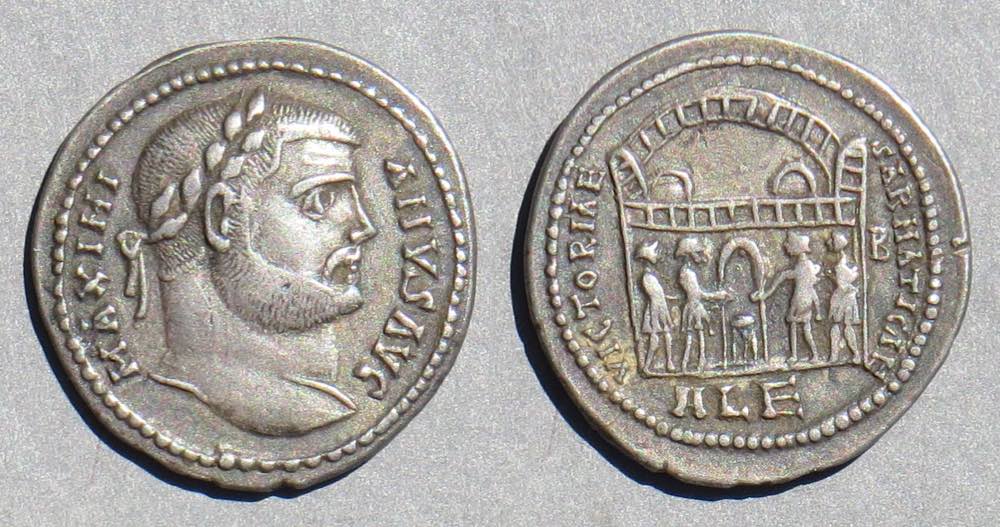
Well, regardless of your final judgement, you at least have to look at the coin. I see a coin with substantial wear, but excellent depth of strike and centering.
19 mm. 3.30 grams. A silver argenteus.
You might wish to know the ID, so here it is:
Maximian (MAXIMIANVS AVG) [286-305]
opposite
Four emperors sacrificing over tripod in front of the gate of a camp or city with towers,
VICTORIAE SARMATICAE and
ALE for Alexandria in exergue, B in field right.
If you have RIC you can go to volume VI and find under Alexandria on page 661 that it is not listed, but the corresponding type is listed for Diocletian as Alexandria 8 ("c. 295") and "R4" ("extremely rare" This coin would be 8b). The other types of argentei from this first issue at Alexandria are all R5 and the second issue has some "R4" with the VIRTVS MILITVM legend.
So, now you know it is very rare (some would say "extremely rare" or even "unique"). Coupled with the pleasing appearance, that boosts the value a lot (to me).
Now, with some more research you can find that any type of argenteus from Alexandria is rare. The Sisak hoard had none. The Gemini auction VIII wrote "Tetrarchic argentei of Alexandria are very rare; for all emperors and all issues, Gautier in 1984 found in museum and private collections and in published catalogues only a total of 39 specimens." The major collection M&M XIII had none. Argentei have been found in the last decade, but catalogs where some were disbursed such as Freeman & Sear 11, 12, and 16 and Manhatten 3 had none from Alexandria. Nomos 3 had 3 from Alexandria, none of this type.
A search at acsearch yields about 53 from the search "argenteus Alexandria" but some are the same coin offered twice and none are of this type. So the coin might be "unique" and a seller would be justified in touting its rarity.
But, it was slabbed. Can you forget all that above and look at what was offered and think how you would think with the following information? Here is what you see when a slab is offered:

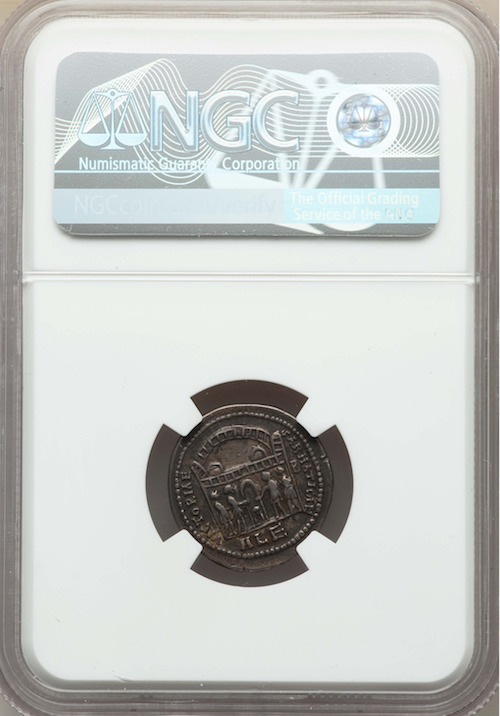
First you see "Ch VF" which is pretty good but low grade for the high-grade-only collector. Look further and you see "Strike 5" (excellent) but "Surface 3, scratches" (not good). Did you look at the coin?
You do not see any significant ID. Neither my photo nor the seller's photo show much in the way of "scratches" (they are very hard to see in the interior of the camp). If you wanted FDC they would be a serious detraction from perfection, but for a "Ch VF" coin they are not much of a detraction. Personally, I like the surfaces with their toning.
The people who bid against me were probably thinking "Only Ch VF and scratches--not good!" I am happy about that because I got it for about the price of a normal, common, argenteus. If you have a slabbed coin, or are thinking of buying a slabbed coin, I think a slab makes it hard to see the coin for what it really is.
Part IV: Tooling and Smoothing.
Here is how I think of tooling and smoothing.
Imagine a line drawing, without shading, of the coin type. That drawing will have some areas of white with no lines where there is no design detail. However, the coin may have corrosion in those areas. If that corrosion is evened out that is "smoothing." No detail was added to the coin.
 A line drawing of a sestertius of Marcus Aurelius.
A line drawing of a sestertius of Marcus Aurelius.
The line drawing will have some lines representing details that will wear off or become weaker with circulation. For example, a well worn sestertius may no longer have the outlines of the leaves on the laurel wreath that you would see in the line drawing of an unworn example. If someone takes a tool and carves leaves where they were, but no longer are, that is tooling.
Some lines in the drawing represent features that are so bold they do not disappear completely even with quite a bit or wear or corrosion. For example, the profile of the bust, the outline of the reverse design, and the outlines of the lettering. If a coin is very worn, these features can be weak. They can be "strengthened" by carving the field around the profile a bit deeper, outlining the reverse type a bit, and digging around the letters to make them stand out. This is in the "tooling" category.
Sometimes corrosion has encrusted or raised bumps on much of the coin. The bumps can be carved off the edges of the lettering and carved off the designs. The line-drawing lines that are afterwards no longer prominent on the coin can be reengraved. The fields can be made level and smoothed. There are some collecting areas where this is so common it is hard to find a coin without all of these (coins of the Kingdom of the Bosporus come to mind).
In conclusion, here is the meaning of the terminology:
If a line drawing of the original had no line there and the coin surface has been carved or buffed to be flatter there, that is smoothing. If the line drawing had a line there and a cutting tool has been used to recreate or emphasize the line, that is tooling.
______________________
Here are some other definitions of smoothing:
The CoinTalk member IdesOfMarch01 wrote Feb. 7, 20120: "At some point the ancient coin ceased circulating. When it did, it had some circulation wear, scratches, etc., and this is the true condition of the coin. Lying undiscovered for centuries or millennia resulted in deposits, detritus, etc. coming into contact and adhering to the coin's surface. Removal of this additional material is what I consider smoothing, since it does not alter the coin's condition after it fell out of circulation. This is why, in general, smoothing is generally regarded as benign, and not as tooling."
Another very succinct definition, pretty much the same as mine, was posted by lrbguy:
"Smoothing is the removal of accretions, including substances which may have chemically bonded with coin material at the surface. Patina is the metallic salt that forms at the surface of the coin, and consists partly of coin material and partly of outside chemicals. But accretions are added deposits and adhere to the surface from outside the coin itself. Clearing those off is what smoothing is about, whether in the fields or in the devices."
Curtis Clay on Cointalk, Feb. 7, 2020, wrote, "The strict and I believe correct definition of smoothing is: removal of actual metal from the surface of a coin in order to make it more attractive by eliminating pitting, scratches, or other defects.
"Removal of deposits on the surface of a coin without cutting into the metal is just cleaning in my view, not smoothing. Yet if such cleaning is clumsy or uneven, often because the distinction between deposits/patina on the surface and actual coin metal is hard to draw, then it will usually be called smoothing these days, inaccurately in my opinion."
Return to the question about grading on page 3 of the FAQ pages for beginners.
How does rarity fit in? See my comments here.
Go to the main Table of Contents page for this whole group of pages.

 Roman Republican silver denarius of Brutus.
Roman Republican silver denarius of Brutus. The coin to the right is a follis of Maximian (286-305), 27 mm. 10.63 grams. Reverse: HERCVLI VICTORI. RIC Alexandria 38. The highest spots, the ear and wreath on the obverse and the beard and right arm of Hercules on the reverse, show virtually no wear. But the chest of Hercules is not well-struck and the on the obverse the chin and back of the neck of have some corrosion pits. For wear alone it could hardly be better, but it does have detractions that are not due to wear. Its grade would be on a linear scale with one number, but there is no way that one number can describe the "condition" of this coin. Don't even try.
The coin to the right is a follis of Maximian (286-305), 27 mm. 10.63 grams. Reverse: HERCVLI VICTORI. RIC Alexandria 38. The highest spots, the ear and wreath on the obverse and the beard and right arm of Hercules on the reverse, show virtually no wear. But the chest of Hercules is not well-struck and the on the obverse the chin and back of the neck of have some corrosion pits. For wear alone it could hardly be better, but it does have detractions that are not due to wear. Its grade would be on a linear scale with one number, but there is no way that one number can describe the "condition" of this coin. Don't even try. Quality. One way to think of the quality of a coin is to imagine a discussion of the type in a book (or web page). Would the coin make a good illustration? Is the legend visible? If you want to illustrate a "Dacian Captive" type under Trajan in a book and the coin is off-center so much that the "DACCAP" in exergue is off the flan, it may "grade" EF or UNC or Mint State, but it would not be a good example of the type.
Quality. One way to think of the quality of a coin is to imagine a discussion of the type in a book (or web page). Would the coin make a good illustration? Is the legend visible? If you want to illustrate a "Dacian Captive" type under Trajan in a book and the coin is off-center so much that the "DACCAP" in exergue is off the flan, it may "grade" EF or UNC or Mint State, but it would not be a good example of the type. Now US coin collecting is sterile. You don't even need to look at the coin--just read the condition off the slab. Rich collectors at the top, unintentionally, but inevitably, determined what was desirable and the rest were trained by publications (Coin World, etc.) to devalue own collections and feel bad they did not have the best quality coins. Some collectors abandoned US coin collecting because of their inability to enjoy what they could afford.
Now US coin collecting is sterile. You don't even need to look at the coin--just read the condition off the slab. Rich collectors at the top, unintentionally, but inevitably, determined what was desirable and the rest were trained by publications (Coin World, etc.) to devalue own collections and feel bad they did not have the best quality coins. Some collectors abandoned US coin collecting because of their inability to enjoy what they could afford.


 A line drawing of a sestertius of Marcus Aurelius.
A line drawing of a sestertius of Marcus Aurelius.